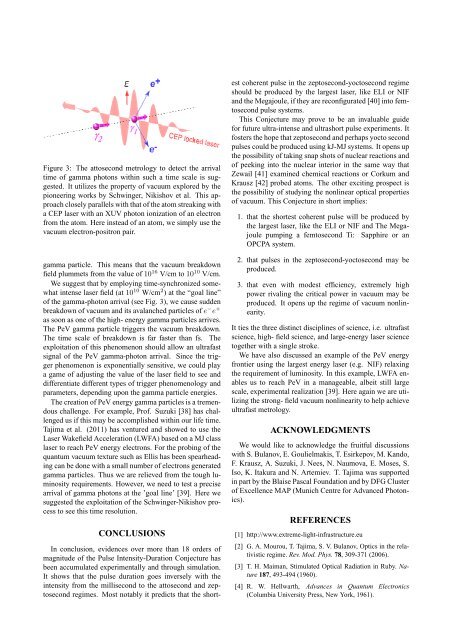Proceedings of International Conference on Physics in ... - KEK
Proceedings of International Conference on Physics in ... - KEK
Proceedings of International Conference on Physics in ... - KEK
You also want an ePaper? Increase the reach of your titles
YUMPU automatically turns print PDFs into web optimized ePapers that Google loves.
Figure 3: The attosec<strong>on</strong>d metrology to detect the arrival<br />
time <str<strong>on</strong>g>of</str<strong>on</strong>g> gamma phot<strong>on</strong>s with<strong>in</strong> such a time scale is suggested.<br />
It utilizes the property <str<strong>on</strong>g>of</str<strong>on</strong>g> vacuum explored by the<br />
pi<strong>on</strong>eer<strong>in</strong>g works by Schw<strong>in</strong>ger, Nikishov et al. This approach<br />
closely parallels with that <str<strong>on</strong>g>of</str<strong>on</strong>g> the atom streak<strong>in</strong>g with<br />
a CEP laser with an XUV phot<strong>on</strong> i<strong>on</strong>izati<strong>on</strong> <str<strong>on</strong>g>of</str<strong>on</strong>g> an electr<strong>on</strong><br />
from the atom. Here <strong>in</strong>stead <str<strong>on</strong>g>of</str<strong>on</strong>g> an atom, we simply use the<br />
vacuum electr<strong>on</strong>-positr<strong>on</strong> pair.<br />
gamma particle. This means that the vacuum breakdown<br />
field plummets from the value <str<strong>on</strong>g>of</str<strong>on</strong>g> 10 16 V/cm to 10 10 V/cm.<br />
We suggest that by employ<strong>in</strong>g time-synchr<strong>on</strong>ized somewhat<br />
<strong>in</strong>tense laser field (at 10 10 W/cm 2 ) at the “goal l<strong>in</strong>e”<br />
<str<strong>on</strong>g>of</str<strong>on</strong>g> the gamma-phot<strong>on</strong> arrival (see Fig. 3), we cause sudden<br />
breakdown <str<strong>on</strong>g>of</str<strong>on</strong>g> vacuum and its avalanched particles <str<strong>on</strong>g>of</str<strong>on</strong>g> e − e +<br />
as so<strong>on</strong> as <strong>on</strong>e <str<strong>on</strong>g>of</str<strong>on</strong>g> the high- energy gamma particles arrives.<br />
The PeV gamma particle triggers the vacuum breakdown.<br />
The time scale <str<strong>on</strong>g>of</str<strong>on</strong>g> breakdown is far faster than fs. The<br />
exploitati<strong>on</strong> <str<strong>on</strong>g>of</str<strong>on</strong>g> this phenomen<strong>on</strong> should allow an ultrafast<br />
signal <str<strong>on</strong>g>of</str<strong>on</strong>g> the PeV gamma-phot<strong>on</strong> arrival. S<strong>in</strong>ce the trigger<br />
phenomen<strong>on</strong> is exp<strong>on</strong>entially sensitive, we could play<br />
a game <str<strong>on</strong>g>of</str<strong>on</strong>g> adjust<strong>in</strong>g the value <str<strong>on</strong>g>of</str<strong>on</strong>g> the laser field to see and<br />
differentiate different types <str<strong>on</strong>g>of</str<strong>on</strong>g> trigger phenomenology and<br />
parameters, depend<strong>in</strong>g up<strong>on</strong> the gamma particle energies.<br />
The creati<strong>on</strong> <str<strong>on</strong>g>of</str<strong>on</strong>g> PeV energy gamma particles is a tremendous<br />
challenge. For example, Pr<str<strong>on</strong>g>of</str<strong>on</strong>g>. Suzuki [38] has challenged<br />
us if this may be accomplished with<strong>in</strong> our life time.<br />
Tajima et al. (2011) has ventured and showed to use the<br />
Laser Wakefield Accelerati<strong>on</strong> (LWFA) based <strong>on</strong> a MJ class<br />
laser to reach PeV energy electr<strong>on</strong>s. For the prob<strong>in</strong>g <str<strong>on</strong>g>of</str<strong>on</strong>g> the<br />
quantum vacuum texture such as Ellis has been spearhead<strong>in</strong>g<br />
can be d<strong>on</strong>e with a small number <str<strong>on</strong>g>of</str<strong>on</strong>g> electr<strong>on</strong>s generated<br />
gamma particles. Thus we are relieved from the tough lum<strong>in</strong>osity<br />
requirements. However, we need to test a precise<br />
arrival <str<strong>on</strong>g>of</str<strong>on</strong>g> gamma phot<strong>on</strong>s at the ’goal l<strong>in</strong>e’ [39]. Here we<br />
suggested the exploitati<strong>on</strong> <str<strong>on</strong>g>of</str<strong>on</strong>g> the Schw<strong>in</strong>ger-Nikishov process<br />
to see this time resoluti<strong>on</strong>.<br />
CONCLUSIONS<br />
In c<strong>on</strong>clusi<strong>on</strong>, evidences over more than 18 orders <str<strong>on</strong>g>of</str<strong>on</strong>g><br />
magnitude <str<strong>on</strong>g>of</str<strong>on</strong>g> the Pulse Intensity-Durati<strong>on</strong> C<strong>on</strong>jecture has<br />
been accumulated experimentally and through simulati<strong>on</strong>.<br />
It shows that the pulse durati<strong>on</strong> goes <strong>in</strong>versely with the<br />
<strong>in</strong>tensity from the millisec<strong>on</strong>d to the attosec<strong>on</strong>d and zeptosec<strong>on</strong>d<br />
regimes. Most notably it predicts that the short-<br />
est coherent pulse <strong>in</strong> the zeptosec<strong>on</strong>d-yoctosec<strong>on</strong>d regime<br />
should be produced by the largest laser, like ELI or NIF<br />
and the Megajoule, if they are rec<strong>on</strong>figurated [40] <strong>in</strong>to femtosec<strong>on</strong>d<br />
pulse systems.<br />
This C<strong>on</strong>jecture may prove to be an <strong>in</strong>valuable guide<br />
for future ultra-<strong>in</strong>tense and ultrashort pulse experiments. It<br />
fosters the hope that zeptosec<strong>on</strong>d and perhaps yocto sec<strong>on</strong>d<br />
pulses could be produced us<strong>in</strong>g kJ-MJ systems. It opens up<br />
the possibility <str<strong>on</strong>g>of</str<strong>on</strong>g> tak<strong>in</strong>g snap shots <str<strong>on</strong>g>of</str<strong>on</strong>g> nuclear reacti<strong>on</strong>s and<br />
<str<strong>on</strong>g>of</str<strong>on</strong>g> peek<strong>in</strong>g <strong>in</strong>to the nuclear <strong>in</strong>terior <strong>in</strong> the same way that<br />
Zewail [41] exam<strong>in</strong>ed chemical reacti<strong>on</strong>s or Corkum and<br />
Krausz [42] probed atoms. The other excit<strong>in</strong>g prospect is<br />
the possibility <str<strong>on</strong>g>of</str<strong>on</strong>g> study<strong>in</strong>g the n<strong>on</strong>l<strong>in</strong>ear optical properties<br />
<str<strong>on</strong>g>of</str<strong>on</strong>g> vacuum. This C<strong>on</strong>jecture <strong>in</strong> short implies:<br />
1. that the shortest coherent pulse will be produced by<br />
the largest laser, like the ELI or NIF and The Megajoule<br />
pump<strong>in</strong>g a femtosec<strong>on</strong>d Ti: Sapphire or an<br />
OPCPA system.<br />
2. that pulses <strong>in</strong> the zeptosec<strong>on</strong>d-yoctosec<strong>on</strong>d may be<br />
produced.<br />
3. that even with modest efficiency, extremely high<br />
power rival<strong>in</strong>g the critical power <strong>in</strong> vacuum may be<br />
produced. It opens up the regime <str<strong>on</strong>g>of</str<strong>on</strong>g> vacuum n<strong>on</strong>l<strong>in</strong>earity.<br />
It ties the three dist<strong>in</strong>ct discipl<strong>in</strong>es <str<strong>on</strong>g>of</str<strong>on</strong>g> science, i.e. ultrafast<br />
science, high- field science, and large-energy laser science<br />
together with a s<strong>in</strong>gle stroke.<br />
We have also discussed an example <str<strong>on</strong>g>of</str<strong>on</strong>g> the PeV energy<br />
fr<strong>on</strong>tier us<strong>in</strong>g the largest energy laser (e.g. NIF) relax<strong>in</strong>g<br />
the requirement <str<strong>on</strong>g>of</str<strong>on</strong>g> lum<strong>in</strong>osity. In this example, LWFA enables<br />
us to reach PeV <strong>in</strong> a manageable, albeit still large<br />
scale, experimental realizati<strong>on</strong> [39]. Here aga<strong>in</strong> we are utiliz<strong>in</strong>g<br />
the str<strong>on</strong>g- field vacuum n<strong>on</strong>l<strong>in</strong>earity to help achieve<br />
ultrafast metrology.<br />
ACKNOWLEDGMENTS<br />
We would like to acknowledge the fruitful discussi<strong>on</strong>s<br />
with S. Bulanov, E. Goulielmakis, T. Esirkepov, M. Kando,<br />
F. Krausz, A. Suzuki, J. Nees, N. Naumova, E. Moses, S.<br />
Iso, K. Itakura and N. Artemiev. T. Tajima was supported<br />
<strong>in</strong> part by the Blaise Pascal Foundati<strong>on</strong> and by DFG Cluster<br />
<str<strong>on</strong>g>of</str<strong>on</strong>g> Excellence MAP (Munich Centre for Advanced Phot<strong>on</strong>ics).<br />
REFERENCES<br />
[1] http://www.extreme-light-<strong>in</strong>frastructure.eu<br />
[2] G. A. Mourou, T. Tajima, S. V. Bulanov, Optics <strong>in</strong> the relativistic<br />
regime. Rev. Mod. Phys. 78, 309-371 (2006).<br />
[3] T. H. Maiman, Stimulated Optical Radiati<strong>on</strong> <strong>in</strong> Ruby. Nature<br />
187, 493-494 (1960).<br />
[4] R. W. Hellwarth, Advances <strong>in</strong> Quantum Electr<strong>on</strong>ics<br />
(Columbia University Press, New York, 1961).













